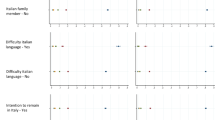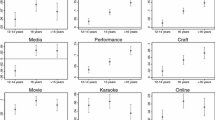Abstract
In this article we study the determinants of cultural participation in Israel with an emphasis on the Weberian distinction between class and status. The class measure is based on occupational groupings, and status is operationalized as a rank of occupations based on social distance. We expect that class will be less important than status in shaping cultural participation patterns. In addition, due to the importance of ethnicity and religiosity in Israeli society, we expect that these factors will be significant in shaping cultural participation. Data are based on two telephone surveys conducted in 2006 and 2007 of a random sample of the Jewish population in Israel. We find that, contrary to our expectation, class is more influential than status. We also find that ethnicity and religiosity are important factors that shape cultural participation patterns. We discuss possible explanations to the finding regarding class and status, with special attention to the role cultural policy plays in mediating the economic effect on consumer behavior. We also call for more attention to ethnicity and religiosity in studies of cultural stratification.
Similar content being viewed by others
Notes
For Bourdieu, however, class is a multidimensional concept that rests on both the objective homogeneity of conditions as expressed in the volume of economic capital and the harmonization of dispositions that flow from the identity of position in the social space as expressed in the volume of cultural capital (Bourdieu 1990).
The Israel Central Bureau of Statistics conducted a survey on leisure and sports in 1998. It contained a long list of questions on different areas of lifestyle and taste patterns but failed to include even a single question on class, occupation, etc. (Central Bureau of Statistics 2002).
A major cleavage in Israel—between Jews and Arabs—is not discussed here. For reasons explained in the data section, Arabs were not included in the survey.
As expected from Weber's discussion on dimensions of stratification, we find the status-order variable to be correlated with class (R = 0.77). It is also correlated with other measures of stratification in Israel, such as socio-economic status (SEI) (r = 0.87), income (r = 0.38), and years of schooling (r = 0.58). These are high correlations, as evident from other literature as well, but each measure represents a separate aspect of stratification and is associated with a different mechanism in the creation of inequality.
Response rate was about 40% in both years, which is the standard response rate in telephone interviews in Israel. We excluded the Arab population from the data collection because the limited size of the sample did not allow a meaningful analysis of the Arab group.
Katz-Gerro (2000) reports that in Israel, unlike some other countries, married respondents engage in highbrow culture more than single respondents, indicating that in Israel highbrow culture is a social activity conducted with a partner. Therefore, it would be more appropriate to use household income.
These results remain the same even when we exclude ethnicity from the analysis.
Since the association between class and status is relatively high (R = 0.77), we also fitted a model that excludes class. The results of this model did not alter our conclusions, and showed that status was statistically insignificant while income was significant.
In a logistic regression analysis contrasting the inactive group and the actives (all the other groups taken together), the results were similar to those reported here.
The class variable that we use in this analysis is based on the Goldthorpe class schema, which is said to be a good proxy for life income (Goldthorpe 2000).
References
Arian, A., & Talmud I. (1991). Economic control and electoral policies. In F. P. Fox (Ed.), Popular power in post-industrial societies (pp. 169–189). Oxford: Polity Press of Basil Blackwell and New York: Oxford University Press.
Ayalon, H., Ben-rafael, E., & Sharot, S. (1991). Religious, ethnic and class divisions in Israel: Convergent or cross-cutting? In Z. Sobel & B. Beit-Hallahmi (Eds.), Tradition, innovation, conflict, jewishness and judaism in contemporary Israel. New York: State University of New York Press.
Beale, A. (1999). From ‘Sophie’s choice’ to consumer choice: Framing gender in cultural policy. Media Culture and Society, 21(4), 435–458.
Benski, T. (1989). Ethnicity and the shaping of musical taste: Patterns in an Israeli urban community. Social Forces, 67, 731–750.
Bourdieu, P. (1984). Distinction: A social critique of the judgment of taste. London: Routledge & Kegan Paul.
Bourdieu, P. (1990). The logic of practice. Cambridge: Polity Press.
Central Bureau of Statistics. (2002). Reading, leisure, and sports survey 1998/99. Jerusalem.
Chan, T. W., & Goldthorpe, J. (2004). Is there a status order in contemporary British society? Evidence from the occupational structure of friendship. European Sociological Review, 20, 383–401.
Cohen, Y., Haberfeld, Y., & Kristal, T. (2007). Ethnicity and mixed ethnicity: Educational gaps among Israeli-born Jews. Ethnic and Racial Studies, 30, 896–917.
Fishman, Y., & Ben-Dror, G. (2001). Cultural budget proposal 2001. Discussion paper. Jerusalem: Knesset (in Hebrew).
Ginsberg, Y. (1975). Joint leisure activities and social networks in two neighborhoods in Tel Aviv. Journal of Marriage and the Family, 37(3), 668–676.
Goldman, A., & Kipnis, B. (2003). Similarity and difference in estimating lifestyle characteristics of Jewish citizens in Haifa. Bitachon Soziali, 64, 88–93. in Hebrew.
Goldthorpe, J. H. (2000). On sociology: Numbers, narratives, and the integration of research and theory. Oxford: Oxford University Press.
Horowitz, D., & Lissak, M. (1990). Trouble in Utopia: The overburdened polity of Israel. Tel Aviv: Am Oved. in Hebrew.
Katz, E. (1992). Leisure culture in Israel. Jerusalem: The Guttman Institute for Applied Social Research. in Hebrew.
Katz, E. (1999). Bracha report: Cultural policy in Israel. Jerusalem: Van Leer Institute.
Katz, E., & Gurevitz, M. (1973). Leisure culture in Israel: Patterns of consumption. Tel Aviv: Am Oved. in Hebrew.
Katz-Gerro, T. (2000). The stratification of cultural consumption: A cross-national comparison of Italy, West Germany, Israel, Sweden, and the United States. Ph.D. dissertation, University of California, Berkeley.
Katz-Gerro, T. (2002). Highbrow cultural consumption and class distinction in Italy, Israel, West Germany, Sweden, and the United States. Social Forces, 81(1), 207–229.
Katz-Gerro, T. (2004). Cultural consumption research: Review of methodology, theory, and consequence. International Review of Sociology, 14(1), 11–29.
Katz-Gerro, T., Raz, S., & Yaish, M. (2007). Class, status, and intergenerational transmission of musical tastes in Israel. Poetics, 35, 152–167.
Katz-Gerro, T., & Shavit, Y. (1998). Lifestyles and social class in Israel. Soziologia Israelit, 1(1), 91–114. in Hebrew.
Kimmerling, B. (2004). Immigrants, settlers and natives: Israel between plurality of cultures and cultural wars. Tel Aviv: Am Oved. in Hebrew.
Lamont, M., & Molnár, V. (2002). The study of boundaries in the social sciences. Annual Review of Sociology, 28, 167–195.
Laumann, E. O. (1966). Prestige and association in an urban community: An analysis of an urban stratification system. Indianapolis, IN: Bobbs-Merrill Company.
Levine, L. (1988). Highbrow/lowbrow: The emergence of cultural hierarchy in America. Cambridge, MA: Harvard University Press.
Peterson, R. A. (2005). Problems in comparative research: The example of omnivorousness. Poetics, 33, 257–282.
Peterson, R. A., & Kern, R. M. (1996). Changing highbrow taste: From snob to omnivore. American Sociological Review, 61, 900–907.
Peterson, R. A., & Simkus, A. (1992). How musical tastes mark occupational status groups. In M. Lamont & M. Fournier (Eds.), Cultivating differences (pp. 152–186). Chicago, IL: University of Chicago Press.
Regev, M. (2000). To have a culture of our own: On Israeliness and its variants. Ethnic and Racial Studies, 23, 223–247.
Regev, M., & Seroussi, E. (2004). Popular music and national culture in Israel. Berkeley: University of California Press.
Shamir, M., & Arian, A. (1999). Collective identity and electoral competition in Israel. American Political Science Review, 93, 265–277.
Shamir, B., & Ruskin, H. (1983). Type of community as a moderator of work-leisure relationships: A comparative study of Kibbutz residents and urban residents. Journal of Occupational Behaviour, 4(3), 209–221.
Shenhav, Y. (2003). The Arab-Jews: Nationalism, religion and ethnicity. Tel-Aviv: Am Oved. in Hebrew.
Smooha, S. (1993). Class, ethnic, and national cleavages and democracy in Israel. In E. Sprinzak & L. Diamond (Eds.), Israeli democracy under stress (pp. 309–342). Boulder, CO: Lynne Rienner.
Stier, H., & Lewin, A. C. (2002). Who benefits the most? The unequal allocation of transfers in the Israeli welfare state. Social Science Quarterly, 83(2), 488–503.
Sullivan, O. (1998). Traditional modernity and religiosity: Time use in Israeli households. The British Journal of Sociology, 49(4), 619–639.
Sullivan, O., & Katz-Gerro, T. (2007). The omnivore thesis revisited: Voracious culture consumers. European Sociological Review, 23, 123–137.
Veblen, T. (1899). The theory of the leisure class. New York: New America Library.
Weber, M. (1968 [1922]). Economy and society. Berkeley and Los Angeles: University of California Press.
Yaish, M. (2004). Class mobility trends in Israeli society: 1974–1991. Lewiston: Edwin Mellen Press.
Acknowledgments
We thank Oshrat Hochman and Guillermo Huberman for research assistance. We also wish to thank Jordi López-Sintas, Stanley Waterman, and participants of the “Social Status, Lifestyle and Cultural Consumption” project for their comments on earlier drafts. Two anonymous reviewers provided thorough and insightful suggestions. The first author was supported by a grant from The Israel Foundation Trustees 29/2006.
Author information
Authors and Affiliations
Corresponding author
Rights and permissions
About this article
Cite this article
Katz-Gerro, T., Raz, S. & Yaish, M. How do class, status, ethnicity, and religiosity shape cultural omnivorousness in Israel?. J Cult Econ 33, 1–17 (2009). https://doi.org/10.1007/s10824-008-9088-5
Received:
Accepted:
Published:
Issue Date:
DOI: https://doi.org/10.1007/s10824-008-9088-5




